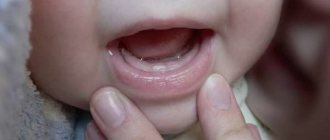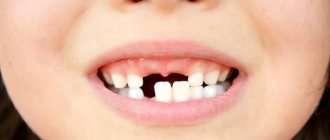Teething in infants and older children is no different: the gums swell, a white spot appears, a tooth emerges, followed by a second one (they appear in pairs).
The only difference is that older children can tell where it hurts and what is wrong, but infants need to be constantly monitored in order to quickly detect approaching teeth and help them grow calmly.
In this article we will talk about the procedure for teething in infants, the main symptoms and ways to make this process more relaxed.
How babies teeth cut: timing and development factors
The foundation of baby and permanent teeth is laid during pregnancy: their health is directly affected by the lifestyle and health of the mother.
After the birth of a child, minerals accumulate in his body, which will become building materials for teeth. The first of them appears when the baby is six months old - this happens in most situations.
But there are many cases where a child was born with a pair of ready-made teeth, or vice versa, when teeth appeared after the first year of life. This is normal: the process is influenced by many factors - from food to place of residence, when exactly teeth are cut.
In total, nature plans 20 milk teeth. They appear in pairs, so teething in infants is usually divided into 10 stages:
- First (medial) lower incisors - 6-10 months.
- First (medial) upper incisors - 8-12 months.
- Second (lateral) upper incisors - 9-13 months.
- Second (lateral) lower incisors - 10-16 months.
- First upper molars - 13-19 months.
- First lower molars - 14-18 months.
- Upper canines - 16-22 months.
- Lower canines - 17-23 months.
- Second lower molars - 23-31 months.
- Second upper molars - 23-31 months.
From 3 to 6 years old, a temporary bite forms in the child’s mouth: it changes when the baby teeth begin to fall out. A temporary bite has a huge impact on a permanent one, and a person’s smile, which will be with him all his life, depends on its correctness.
Along with 20 milk teeth, the roots of 16 permanent teeth appear. The rest grow up at a later age.
We emphasize once again that deviations from the schedule are normal, even within a few months. To be sure, consult your pediatric dentist.
Teething sequence
Of course, we will talk about the standards according to which the optimal time and order of appearance of the first molars is determined. But don’t be upset if the baby’s personal schedule is behind or in a hurry in relation to this “schedule”. The discrepancy may well reach six months in one direction or the other, so if teeth are already making themselves felt at 3 (three) months, this should not be a cause for concern.
There is the following scheme for the eruption of primary molars:
- 5–7 months - a pair of lower frontal incisors;
- 8–10 months - upper front incisors;
- 10–12 months - a pair of lateral incisors on the upper jaw;
- 11–14 months - lower lateral incisors;
- 12–15 months - first the upper first molars, and then the lower ones;
- 16–23 months - upper, then lower canines;
- 24–30 months - upper, lower second molars.
If the frontal incisors emerge at three months, this is normal, but make sure that the first pair is formed first, and only then, for example, one of the lateral incisors. It is important to immediately rule out pathology in order to take the necessary measures in time.
Signs of teething in infants
The only primary sign of the appearance of the first teeth is the appearance of a white spot on the gum (transparent through the thin skin of the enamel).
The remaining signs can be considered secondary - they are not always symptoms of teething:
- Poor sleep, appetite, mood.
- Red hot cheeks.
- Pain in the nose and ears, runny nose, sore throat.
- Increased salivation (sometimes this causes vomiting - the child constantly swallows his saliva).
- Fluid blisters and redness on the gums.
In some cases, a soft ball of liquid (pink or slightly bluish) may appear on the gum where the first teeth appear. This is a common occurrence, but if the lump has become very large and is bothering the child, you should consult a dentist.
Important:
fever, vomiting, and diarrhea are not consequences of teething in infants. They may be the result of certain symptoms (for example, vomiting due to excessive swallowing of saliva). But in most cases, the cause is other diseases that require treatment. If your child is teething and this is accompanied by fever, nausea, or abdominal pain, you should consult a doctor.
Picture of the appearance of the first molars
Remember, the main thing is that the first teeth erupt before one year. At the same time, do not expect that the process itself will proceed according to the textbook - some children tolerate it easily and almost unnoticeably, others experience intense discomfort.
Sometimes teeth at 3 (three) months begin to manifest themselves very seriously, for example, tissue soreness, refusal to eat and high fever. A runny nose and vomiting are possible as a result of copious discharge.
Regarding the order of eruption and what symptoms appear and how easy or difficult the process itself is, the genetic factor is often of great importance here. Ask how everything went for you, and you can compare the picture of manifestations and draw certain conclusions for the future.
How long does it take for first molars to erupt?
When a child has already lost several teeth, parents have an idea of the duration of the process, but when the very first one appears, it is still difficult to talk about it. The first symptoms begin to appear about a month before actual eruption. For some the duration is a month, for others it is two weeks, everything is very individual.
This can also be used to judge when the baby will have all his milk teeth (20 molars in total). Early teething means that the baby will most likely acquire a whole set of hard formations by the age of two. In such children, new molars appear almost every month and are not accompanied by serious difficulties. For others, this same set is formed only by the age of 3.5, which is also normal.
How to help a child?
It is impossible to speed up the process of teeth appearing - sometimes it drags on for weeks (for one tooth). The maximum that parents can do is to reduce the number of unpleasant symptoms.
- Vibucol suppositories can be used as a sedative.
- As a pain reliever - children's versions of Nurofen and Panadol.
- As a hygiene product for the oral cavity - gel-based anti-inflammatory toothpastes for children from 0 years old. Asepta Baby paste is designed for little ones. It does not contain fluorides, parabens, or abrasives. Gently cleans teeth, saturating them with calcium. The paste tastes good and is safe - if the child wants, he can swallow it without harm.
Read more about ways to help your baby during teething in other articles in this section.
Baby's behavior during teething
When children are teething , parents are very worried about how the baby will survive this rather long and often difficult period.
We will not repeat ourselves about the order and pattern of growth of baby teeth. Another of the most common questions is: how many baby teeth do children have? We answer: normally, by the age of one year, the baby should have 8 full incisors - four on the bottom and four on top. By the age of 2 - 16, and by 2.5-3 years all milk teeth - 20 - have grown. By the way, all baby teeth fall out without exception and permanent teeth grow in their place.
Symptoms of teething in a child
But the symptoms of teething in a child can be completely different. Some children tolerate this time calmly; parents do not even know that the child is teething. It’s just that at one moment mom notices that the teeth are already there. Other children show obvious anxiety - their gums constantly itch, they try to chew something, rub their gums against each other, and there is constant salivation. Often the baby becomes whiny, irritable, and sleep is disturbed. The child may even refuse food because it hurts. In these cases, special gels for relieving painful sensations, which are sold in pharmacies, help well. You should also purchase a special silicone finger tip for wiping your gums and cleaning the first teeth that appear. If the mother regularly carries out this procedure from a very early age of the baby (3-4 months), in the future there will be no problems with the child brushing his teeth independently.
restless behavior during teething may also be due to many complications of this period and individual reactions of the body. This may include fever, upset stomach, vomiting, diarrhea, runny nose, and increased drowsiness. Much less often, there may be skin rashes, as well as isolated convulsions, which are most often associated with high fever.
If you are concerned about the baby's condition, especially the child's high temperature during teething , be sure to call your local pediatrician or contact our clinic for advice. We do not recommend listening to the advice of random people, and even grandmothers. It’s just that modern medicine has come a long way, and many of grandma’s recipes are outdated, especially since most of them are completely ineffective. Only a professional can competently assess the situation, including the correct formation of the bite, differentiate the symptoms of teething from other diseases, and choose the most affordable way to help the baby during this crucial period of his life. How to help a child, what you can do and what you absolutely cannot do - read the article “How to help a child when teething.”
Should I worry?
It is important for parents to understand that the cutting of the first molars is often quite difficult; you should not be afraid of many manifestations. Let's figure out when there is no need to panic, what is the norm. The following symptoms are not considered a cause for concern:
- Copious secretion of saliva. In general, this is typical for most children between 10 weeks and 4 months. Just stock up on bibs and you won't have to worry about hygiene;
- Skin irritation (area around the mouth, chin). This symptom is the result of the same salivation, so do not forget to dry your baby’s skin in time and use an emollient cream before bed;
- Frequent desire to take the breast. This is explained by the desire to scratch the gums; this is normal and should not be denied to the child; it usually goes away pretty soon.
When there is cause for concern
In order for the new molar to erupt as easily as possible, it is necessary to pay a lot of attention to the child; also, each little person has his own pain threshold. Usually the most difficult thing in this regard is the appearance of the very first teeth, as well as the incisors.
Sometimes while breastfeeding, the baby's pain increases so much that he begins to refuse to eat. If you miss 2-3 feedings, you should not worry, but if this number is exceeded, you need to consult a pediatrician.
Also, loose stools are not considered normal; it is caused by excessive salivation during teething. As described above, persistent diarrhea with the appearance of blood should not be underestimated.
What else to pay attention to
It happens that small bumps appear on the gums, that is, a minor hematoma. But you shouldn’t be afraid of this, the formation resolves on its own, cold compresses help a lot.
Sometimes, when the incisors are getting ready to appear, pain also occurs in the chin and ears. The child begins to rub his face or chin, but sometimes this is also a symptom of an inflammatory process in the ear, so a consultation with a specialist will not be superfluous.
A little advice: if the baby is spinning in bed and does not fall asleep, you should not immediately calm the child down, it is better to let him deal with it on his own. You need to pick it up and give it milk when you can’t fall asleep for a long period of time.
Another difficulty is increased salivation, due to which the child begins to cough, and when mucus gets into the nasopharynx, an accompanying runny nose develops. If there are additional symptoms that cause concern, you should contact your pediatrician.
What to do when children are teething?
The most natural and one of the most reliable ways to reduce pain is cold. Pick up an item - a “rodent” that can be put in the refrigerator. Freezing them is not recommended because it can damage the baby's delicate gums.
Often children prefer to gnaw on their parent's finger or, unfortunately, on their mother's breast. But parents may not have enough patience for a long time, so it is better to find a suitable teether.
It should be:
- whole and durable (the child should not bite off pieces that could cause choking);
- without ropes and beads (the rope can pinch the neck or break, creating a risk of choking on a bead);
- without paint with toxic components;
- just clean (no need to disinfect it).
You can refrigerate the fruit puree or put a few wet cloth toys in the refrigerator so you can replace them.
Of course, children chew not only objects that are ideal for this. But if with a teether made of one piece of silicone or a mitten with a silicone pad the child can be left alone in the playpen for some time, then with a bunch of small objects on a string around the neck or a bracelet made of beads, the same as with some fruit or vegetable, you need to look after it.
If cooling does not help, and the stress of teething is very severe, discuss taking pain relievers and fever reducers (ibuprofen is most often used) with your pediatrician. To be on the safe side, consult your doctor, but a single dose by weight (for ibuprofen is 10 mg/kg), given once at night for 3-4 days of active teething, will not cause harm.











